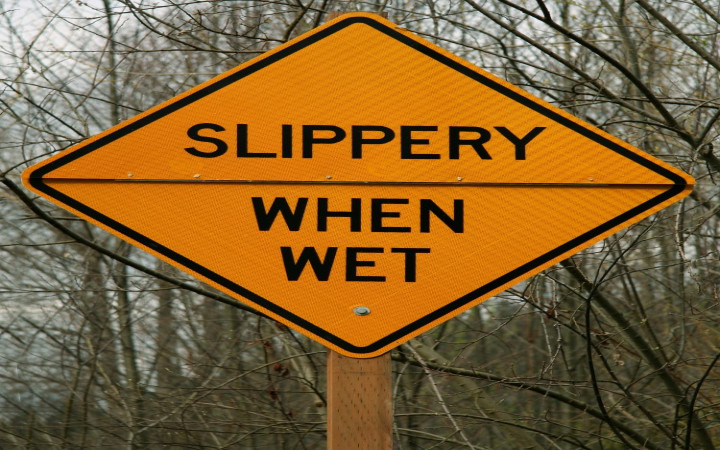Do you ever gaze out the car window while your parents are driving you to and from school, church, or soccer practice? As the road signs fly by, do you ever WONDER what all those numbers and interesting symbols mean?
There's one sign, in particular, that you may have seen from time to time. It usually looks like a car with a couple squiggly lines underneath it. What could this funny-looking sign mean? Caution: earthworms ahead? Don't drive over spaghetti? Bacon will make your car fly?
While all those are funny possibilities, that curious sign actually means slippery when wet. It's a reminder to drivers to be extra-careful when driving during or shortly after it rains.
If you've ever played in the street during or after a rainstorm, you may be skeptical about such a warning. After all, a wet street probably doesn't seem all that slippery when you're in your tennis shoes. Why would it be dangerous to drive on?
Before examining the effects of water on a road, let's first take a look at what force helps to keep cars on the street and drivers in control. When rubber tires meet the road, their motion across the road creates a force known as friction.
For example, the weight of a car pushing down on its tires pushes the rubber of the tire into the thousands of tiny pits that make up a typical road surface. Vibrations from the road surface combine with the deformation of the rubber to create heat, producing friction that helps the tires "stick" to the road.
When it rains, the water on a road causes a loss of friction. As tires move over a wet surface, the water fills in the tiny pits in the road surface, effectively smoothing out the surface. As a result, the normal heat and friction created is decreased, leading to a surface that is more slippery than when dry.
If there's a lot of water on the road, including standing water in puddles, even more severe loss of friction can occur. In these cases, a car's tires can completely lose contact with the road surface as they surf along on a thin layer of water. When this occurs, it's called hydroplaning, and it can be very dangerous.
There are also substances on roads that can lead to a loss of friction when water is added. For example, most dry roads contain a layer of tar, rubber, and oil. When it starts to rain, these substances can mix with the water, creating a greasy layer that can be very slippery.
So what can you do to prevent accidents when you're driving in wet conditions? The first rule of driving on potentially-slippery surfaces is slow down! Feel free to drive well below the speed limit if necessary to help maintain control of your vehicle. If it is raining severely and hydroplaning is a possibility, pull over to the side of the road until conditions improve. Lastly, make sure your tires are in good condition and properly inflated.




